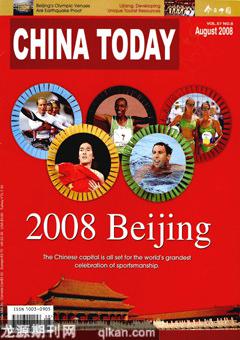The Olympic Village
By staff reporter XI WEN

ON the northern end of the north-south central axis in Beijing is the Olympic Green, where the Olympic Village is located. The 163-acre village will be home to over 16,800 athletes, coaches and officials during the Games. The village logo comprises three parts; the phoenix at the top represents the Olympic flame, while the last two characters represent the words “Dream World.”
Well-equipped
According to Wu Jingmi, director of the BOCOGS Olympic Village Department, the village will be in use from July 27 to August 27, 2008 for the Olympics, and from August 30 to September 20 for the Paralympics.
The village is divided into residential and international quarters. The residential area, the main component, not only has apartments, but also a clinic, restaurants, a library, a recreation center, and an exercise zone where residents can play tennis and basketball, swim and go jogging.
The main restaurant in the village can seat 5,000 and offers 24-hour service. Other restaurants supply a variety of dishes. People of different ethnic groups and different religions can all find their favorites.
Meanwhile, there are also places for religious worship in the village. Chapels for Buddhists, Christians, Hindus, Moslems and Jews are established.
The clinic provides medical services and drug tests. The NOC service center is in charge of logistics. Residents inside the village may take the 24-hour shuttle bus to travel to different blocks.
A commercial street occupied by Beijing Olympic partners stands in the village. To highlight Beijings special features, the street is built as a traditional Beijing street, with courtyard-style houses.
Different from the residential area, the international area is the place to hold welcoming ceremonies, receptions and other activities. Various art performances will be staged at the 20,000-square-meter Olympic Square, while the national flags of all the participating countries and regions will add color in the squares center.
Chinese Elements
The 42 apartment buildings, which are six to nine stories high, are scattered across four districts. Wooden corridors in District A are reminiscent of southwest China; the building style in District B is symmetrical and sturdy, representing northwest China; District C resembles an elegant garden in southeast China; and, finally, District D, which lies close to the Olympic Forest Park, offers splendid natural scenery, as in northeast China.
Built of gray brick and accented by white walls and wooden boards, the buildings look like a traditional Chinese ink painting. Four animals with an auspicious meaning are carved into the apartment walls. The handicrafts, calligraphy work and seal cuttings inside each room express traditional Chinese culture.
The balconies are divided into two parts. The closed section can be used as storage, while the wooden balusters of the open section ensure ventilation and privacy.
The average living area per person is 22.5 square meters. Beds have been designed to be 2.2 meters long, and a special stool is added to the end of the beds for giants like basketball star Yao Ming. To assure that the athletes get a good nights sleep, the rooms are fitted with sound-proof and heat-proof windows.
In addition, each room has been equipped with a broadband line, a telephone, closed-circuit television programs, infrared burglar-proof warning devices and fingerprint locks. Every athlete and official is entitled to an identification card with which he or she may make purchases online and contact family.
Easy Living
One can easily reach Olympic venues from the village by road or metro. It takes no more than 30 minutes to get from the village to the venues, 20 minutes to the airport, and 15 minutes to the city center.
According to Liu Jingmin, vice mayor of Beijing and executive vice president of the Beijing Organizing Committee for the XXIX Olympiad, by Olympic convention International Olympic Committee officials are provided with cars and drivers. Shuttle buses will transport athletes, coaches, registered journalists and technical officials. At least 8,000 vehicles will be needed for these groups. Audiences, volunteers and organizing staff can take public transport free-of-charge.
Qualified caterers will feed the athlete village, the media village, the main press center, the reception center and 29 venues. Liu Jingmin has insisted that the dishes must meet the athletes demands on nutrition and energy, as well as take account of their beliefs and tastes. “We also want to add the Chinese element, to let the participants enjoy Chinese cuisine,” Liu said. Asian dishes, including Chinese, Japanese and Korean, comprise 30 percent of the menu. Nevertheless, Liu said, up to 230 types of dishes will be served every day, and no main dishes will be repeatedfor eight days.
Ensuring a high-level and safe catering, the food security supervising system will be in place and responsible staff trained.
Environmentally Friendly
The designs and facilities in the Beijing Olympic Village fully convey the idea of a “Green Olympics, a Hi-tech Olympics and a Peoples Olympics.” Apart from adopting environmentally friendly materials, the project has also made use of solar and wind energy. For example, the lighting in the village uses solar power, and hot water is generated with solar heat collecting tube technology. Such facilities may save as much as RMB 50 million every year, and it is the first residential area in China to use energy saving facilities on such a large scale.
Additional Information: Security at the Beijing Olympics
According to Olympic security regulations, guns, drugs, explosives, and poisonous and radioactive materials are banned from Beijings Olympic venues. Animals, drinks, radio equipment, banners and oversized flags are also prohibited. Vehicles aside from baby carriages and wheelchairs are forbidden to enter the venues.
Everyone entering the venues must pass the security check gate and metal detectors. Only vehicles with authorization will be allowed to enter the venues. For safetys sake, all athletes must register whenever leaving their domicile.

